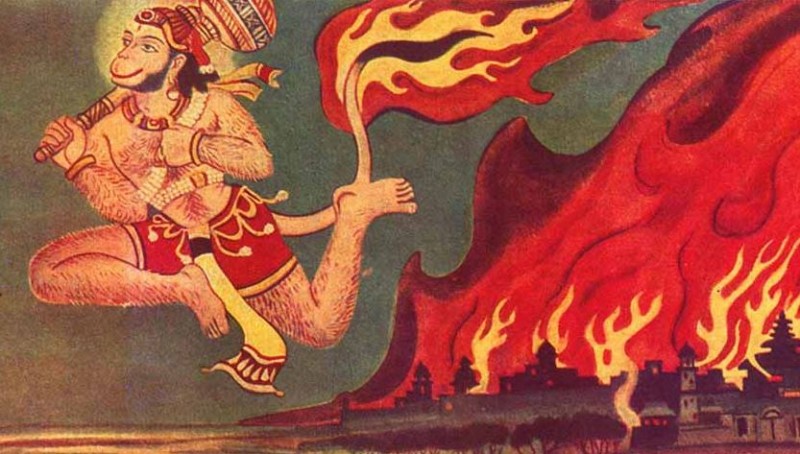
The burning of Lanka is one of the most iconic and captivating episodes in the Indian epic Ramayana. While it is generally believed that Hanuman single-handedly set fire to Lanka, an in-depth analysis of the RamcharitManas reveals that this fire was the result of the collective contribution of five entities. The purpose of this article is to shed light on the roles played by Lord Rama, Ravana's sin, Sita's anger, Vibhishana's chanting, and Hanuman's father Vayu Dev in the destruction of Lanka.
Role of Lord Rama:
Though this may sound confusing, Lord Rama played an important role in Lanka Dahan. Hanuman ji said that God knows that not even a leaf moves without your consent. Thus, the burning of Lanka is a significant event. Hanuman ji also mentioned that when he wanted to meet Sita Mata by hiding in Ashok Batika, there was a herd of demons there, and one of them was your devotee Trijata. She had indicated to me that you were already preparing for Lanka Dahan through her.
Ravana's sinful nature:
Ravana, the demon king of Lanka, was known for his arrogance, wickedness, and utter disregard for moral values. His lust for power and desire for Sita led to the heinous act of her abduction. The countless atrocities he committed during his reign accumulated as sinful deeds, which eventually led to the collapse of his kingdom. In the cosmic balance of justice, his malice contributed to the inevitable destruction of Lanka.
Sita's agony:
Sita, a symbol of purity and virtue, endured immense pain during her captivity in Lanka. Her anguish and anger, though justified, fueled the metaphorical fire that engulfed the demon-empire. It is necessary to understand that her anger was not an act of revenge, but a reflection of her wounded spirit and the collective pain of all oppressed women under the tyranny of Ravana.
Vibhishana's advice:
Ravana's younger brother Vibhishana played a vital role in the burning of Lanka. His unwavering loyalty to dharma led him to break away from Ravana's camp and seek refuge in Lord Rama. Vibhishana's timely advice to Lord Rama about Ravana's weaknesses and Lanka's defense strategies proved invaluable during the ensuing war. His insights paved the way for Rama's conquest and the eventual destruction of Lanka.
Hanuman's father, Vayu Dev:
Hanuman, a devoted follower of Lord Rama, played a crucial role in discovering Sita's whereabouts in Lanka. When Hanuman ji set fire to Lanka, his father, Vayu Dev, unknowingly became involved in this act, intensifying the flames and completely destroying Lanka.
The burning of Lanka was not merely the result of Hanuman's actions; it was a collective effort, linked to cosmic karma and divine intervention. Lord Rama's adherence to dharma, Ravana's sinful nature, Sita's distressed soul, Vibhishana's advice, and Hanuman's father Vayu Dev's unintentional involvement, all contributed to the grand spectacle of Lanka's destruction. The Ramayana serves as an intense metaphor, providing valuable insights into the complexities of human emotions, the importance of religiosity, and the consequences of actions. Understanding the role of these five entities in burning Lanka enriches our understanding of this timeless epic and sheds light on the complex relationship between the actions of different beings in shaping the course of history.
Inside Ron DeSantis' Spiritual Journey and Political Path
Unraveling Adolf Hitler's Religious Beliefs: A Complex Historical Inquiry